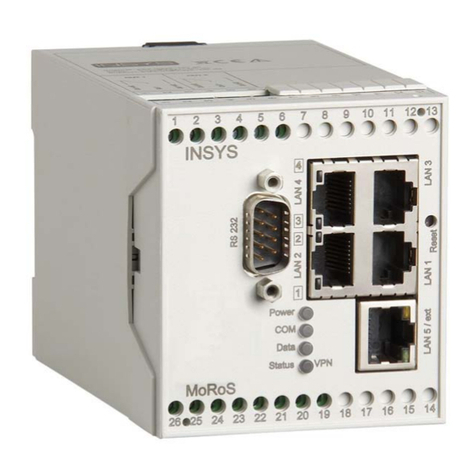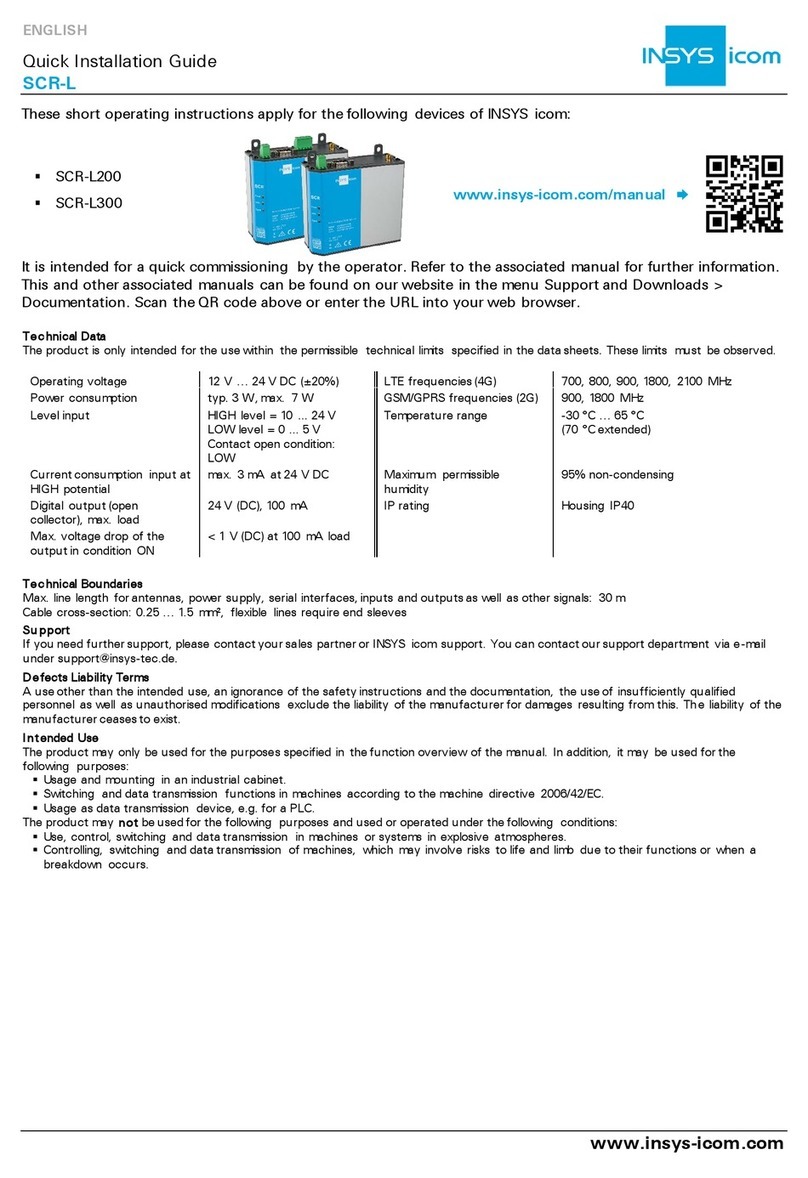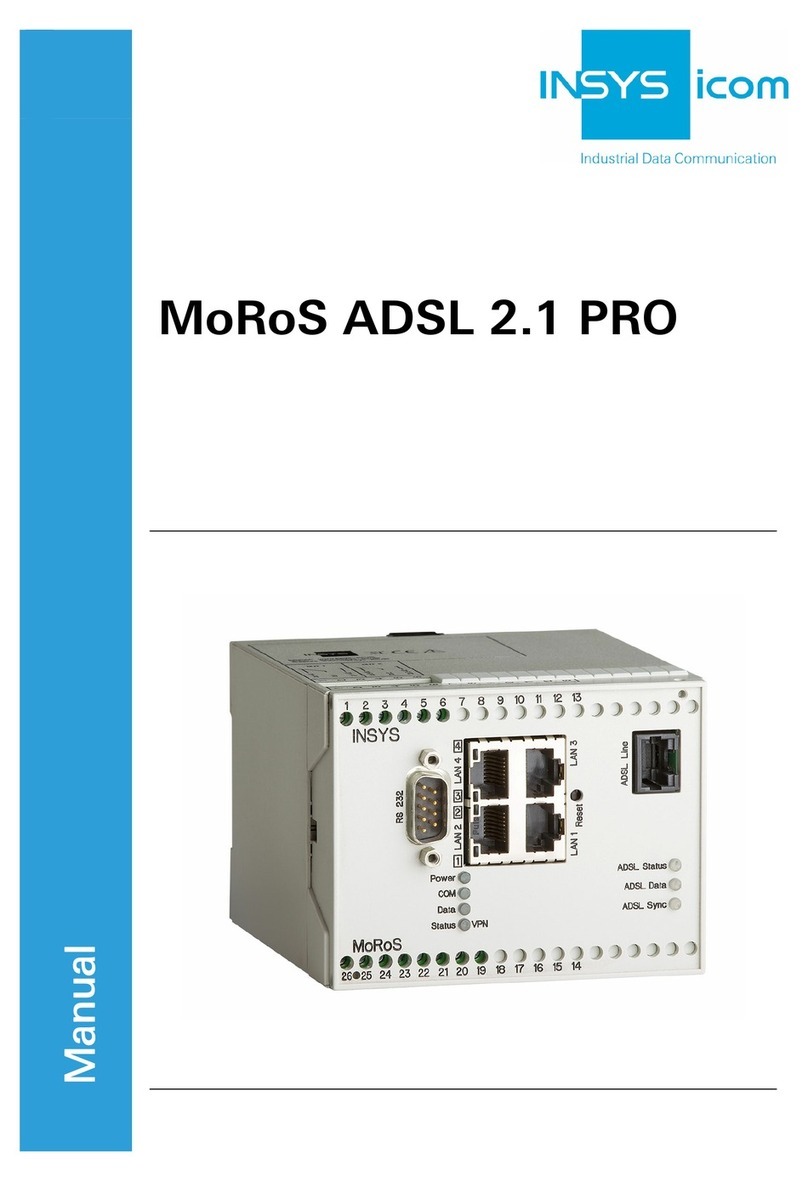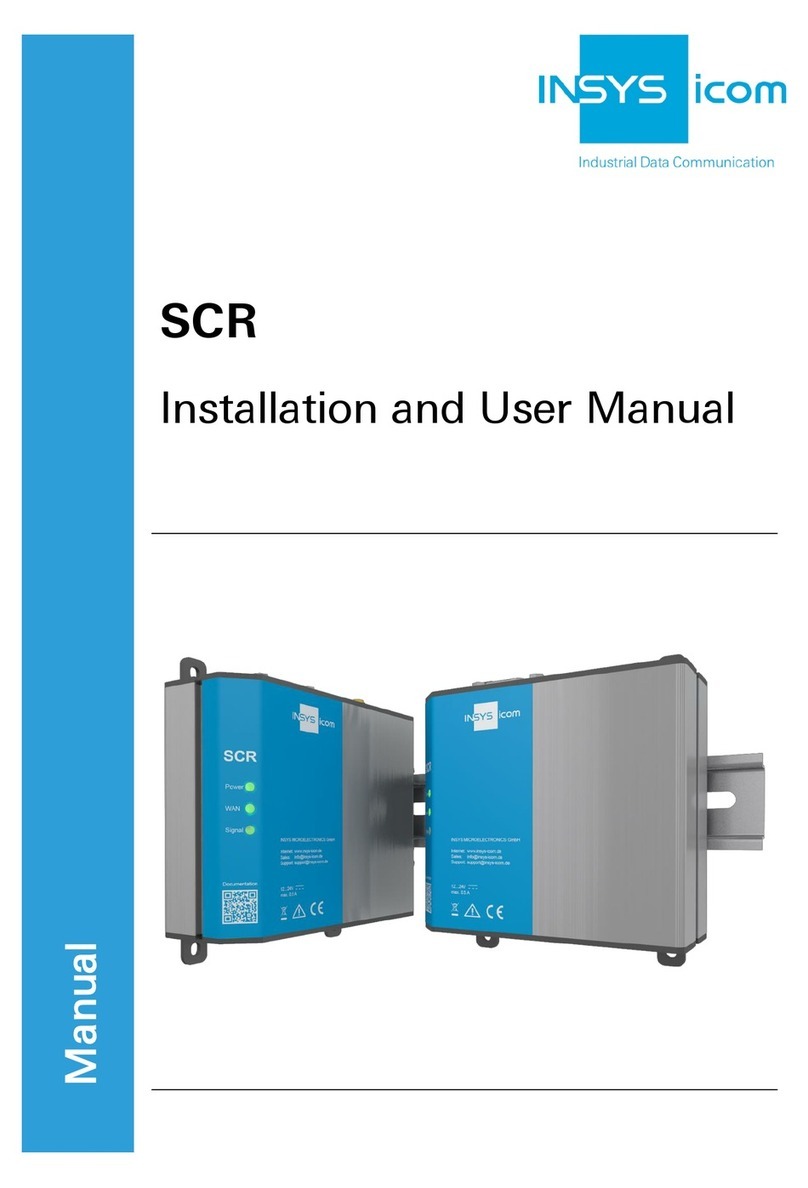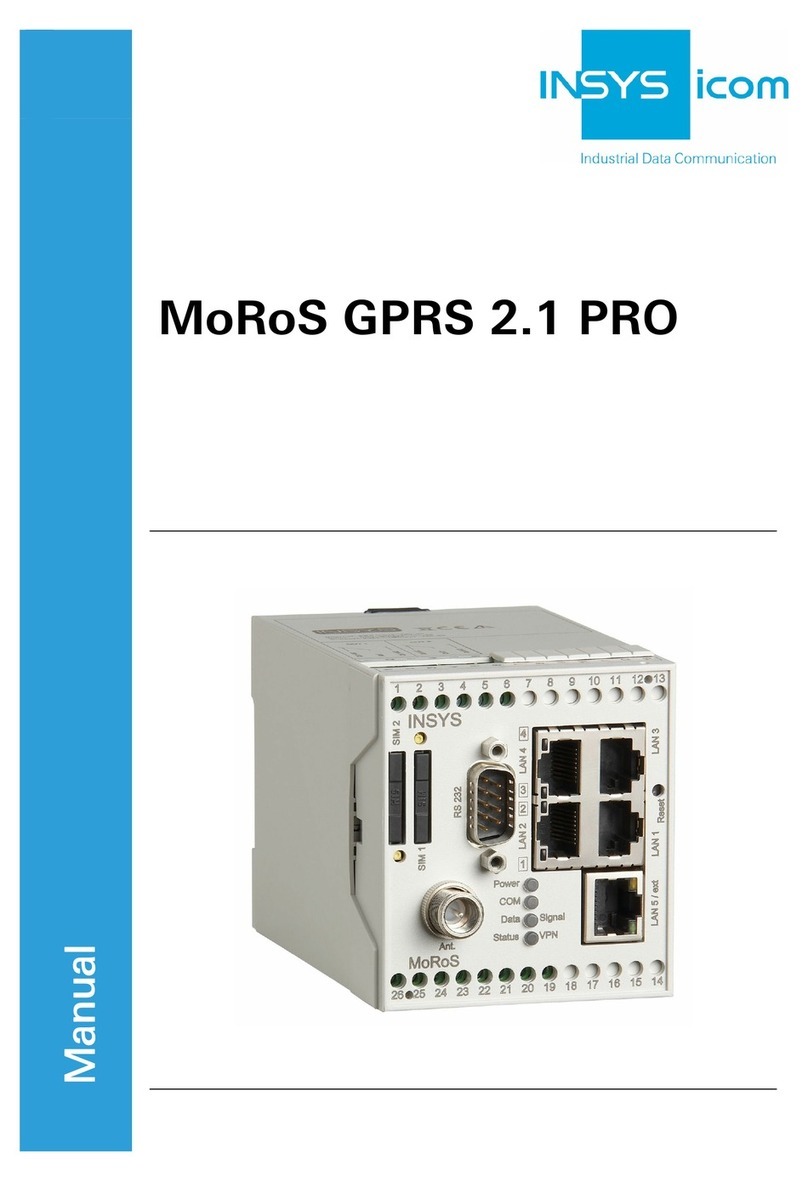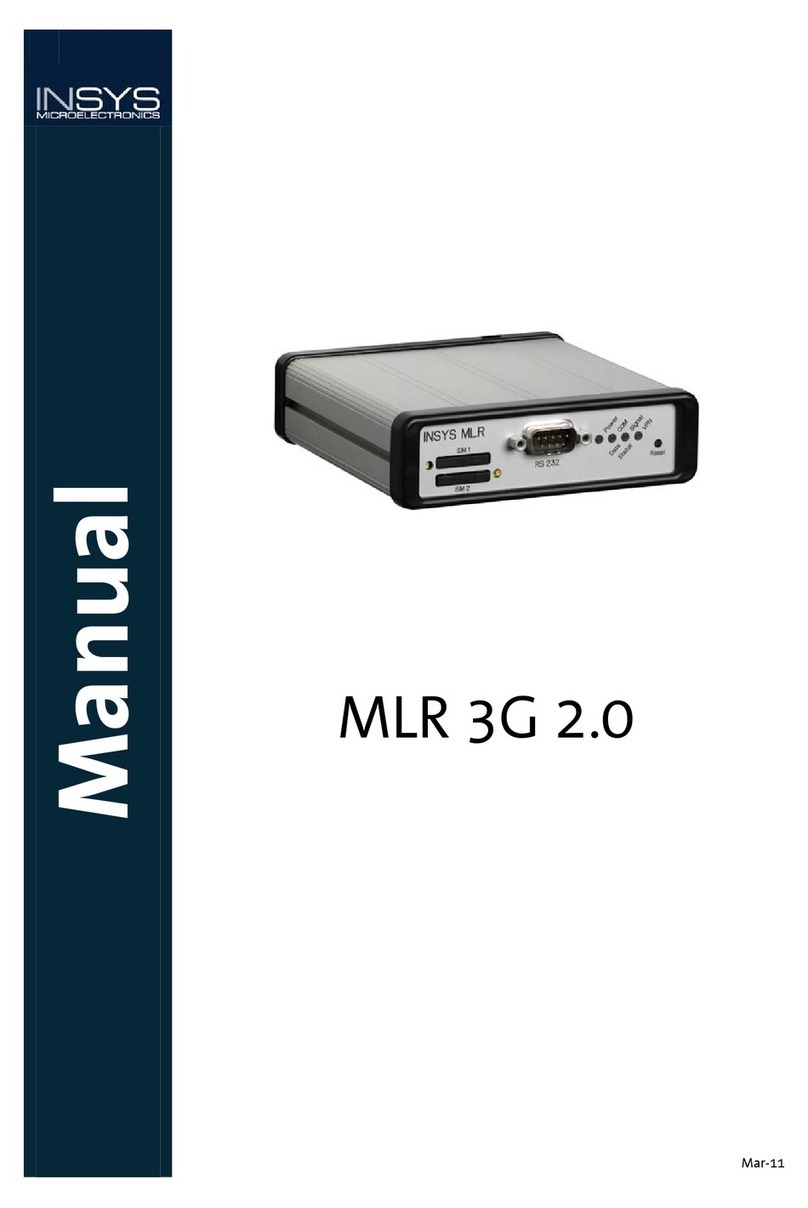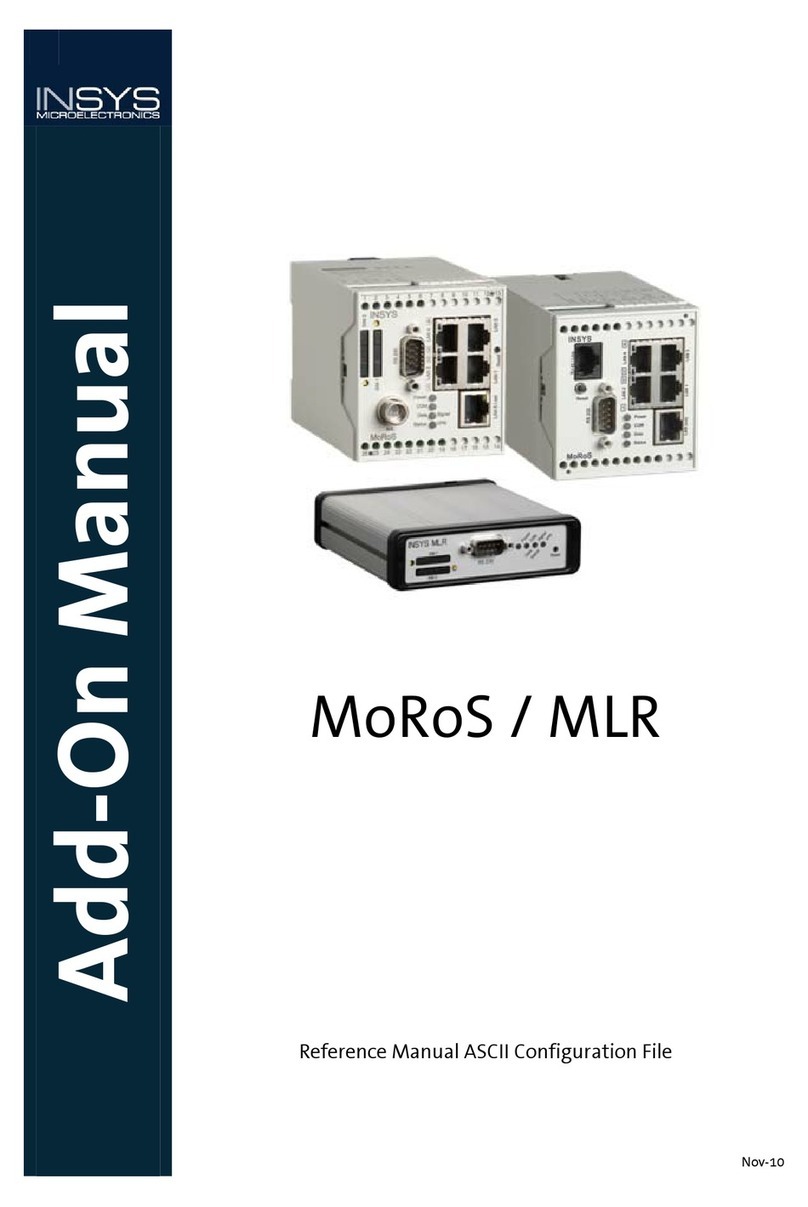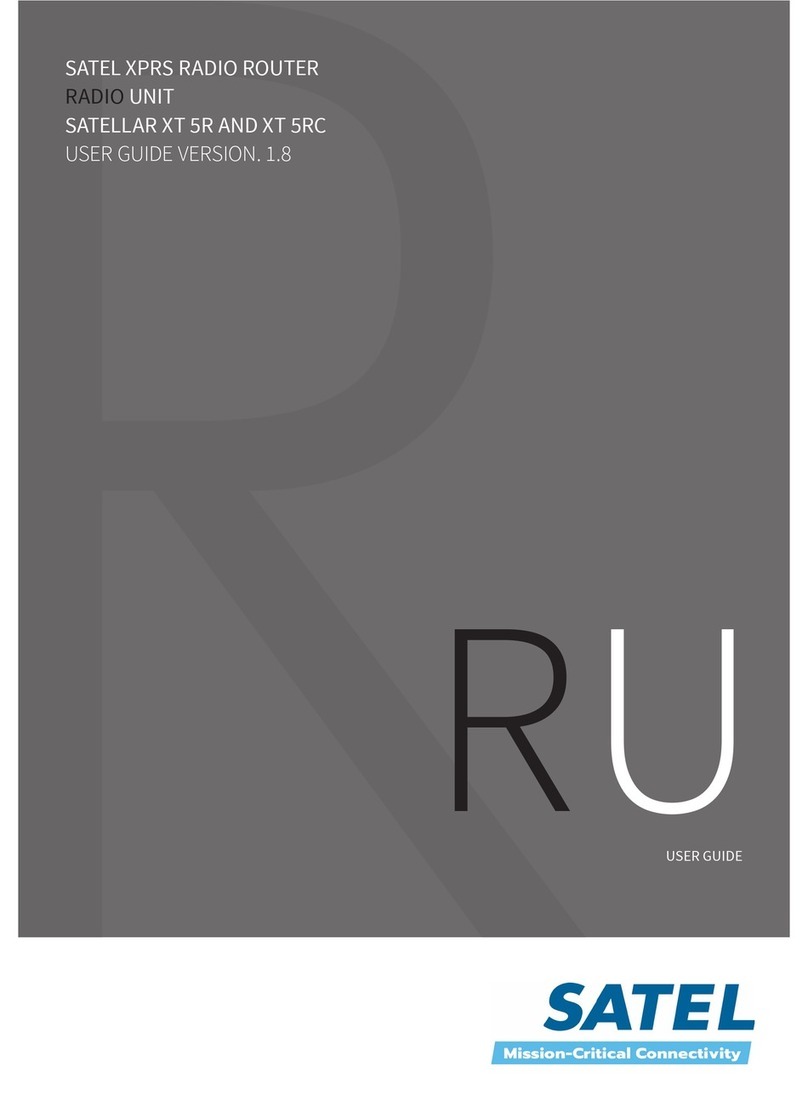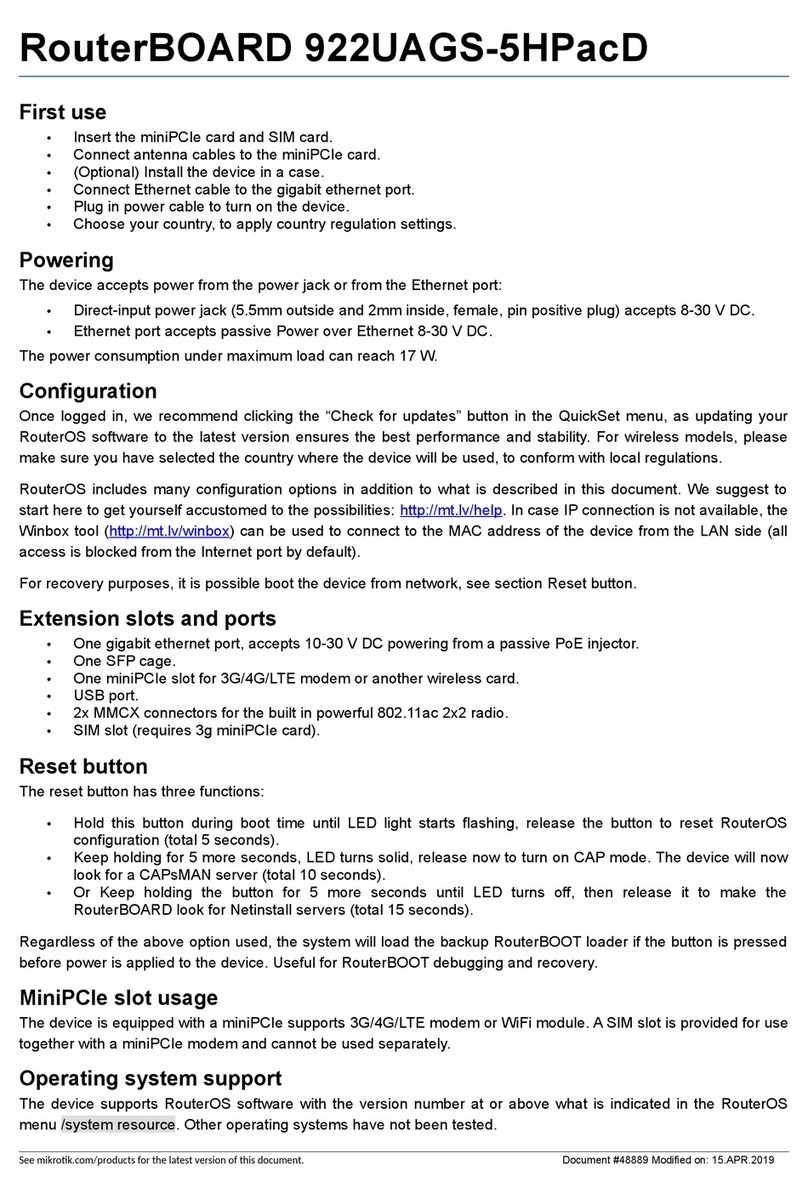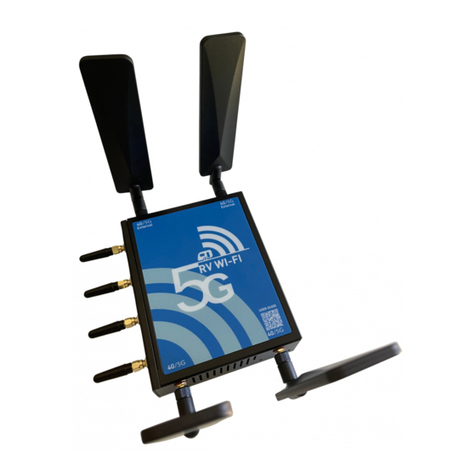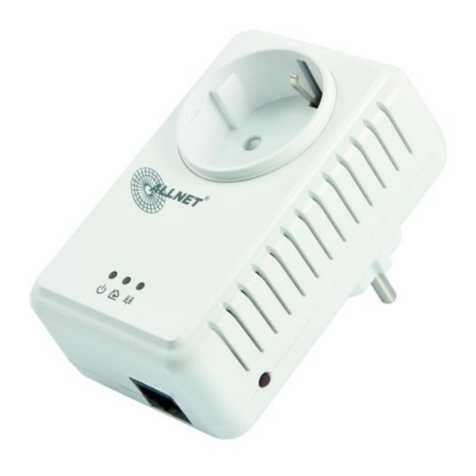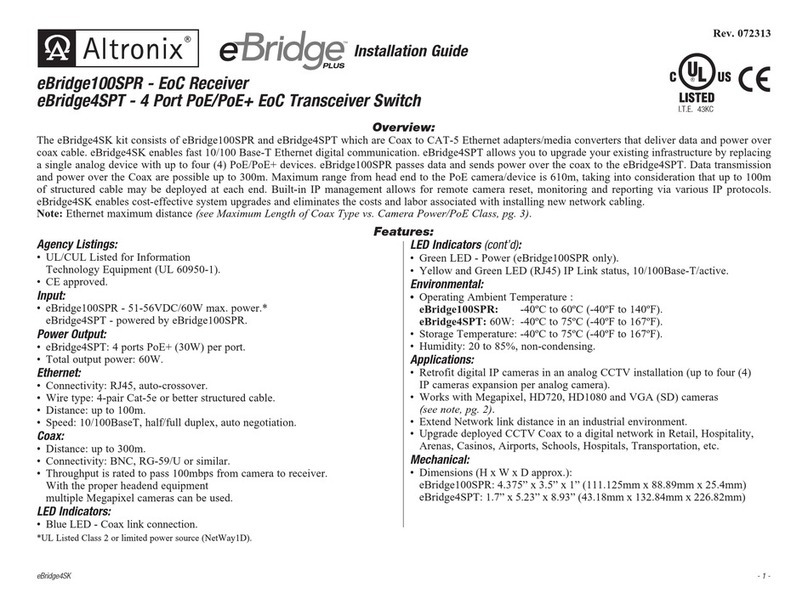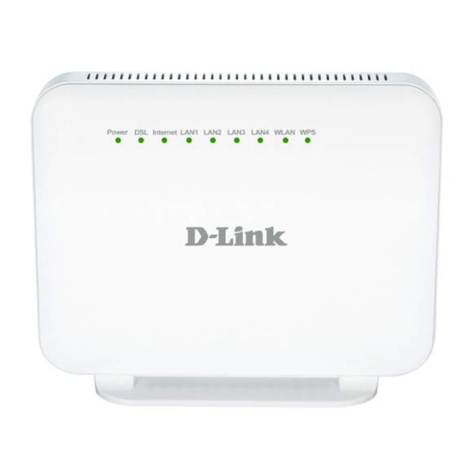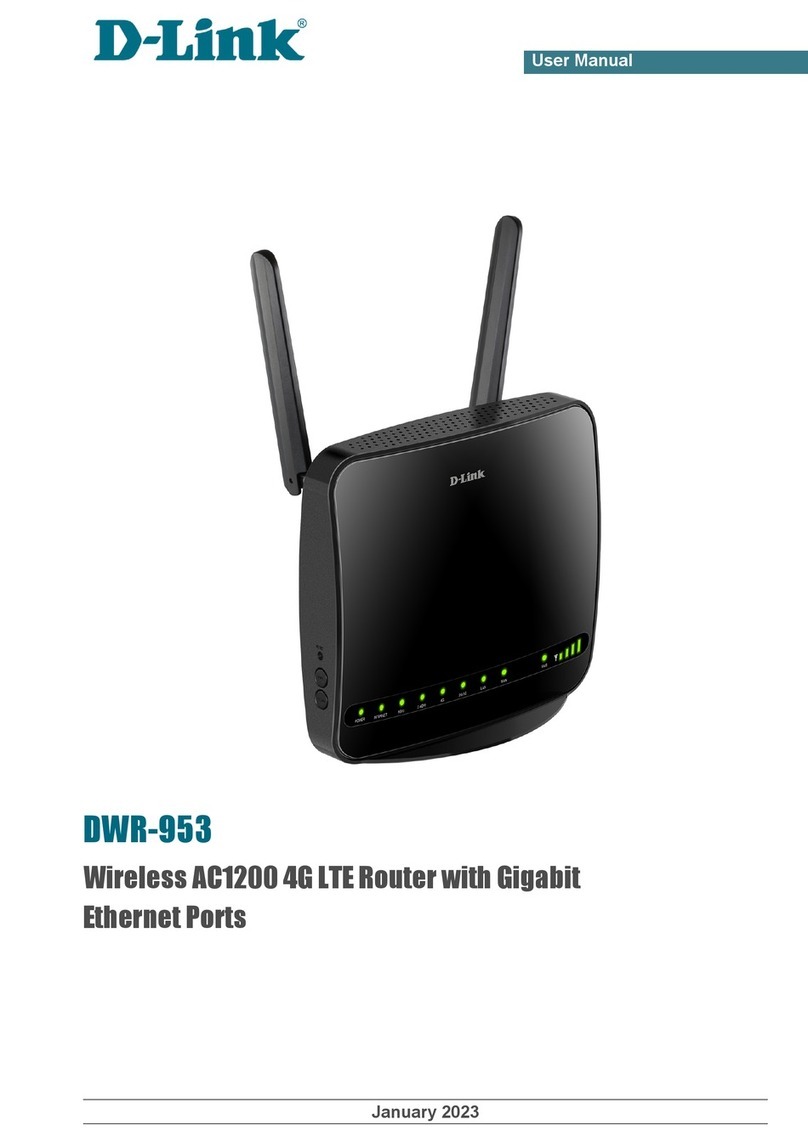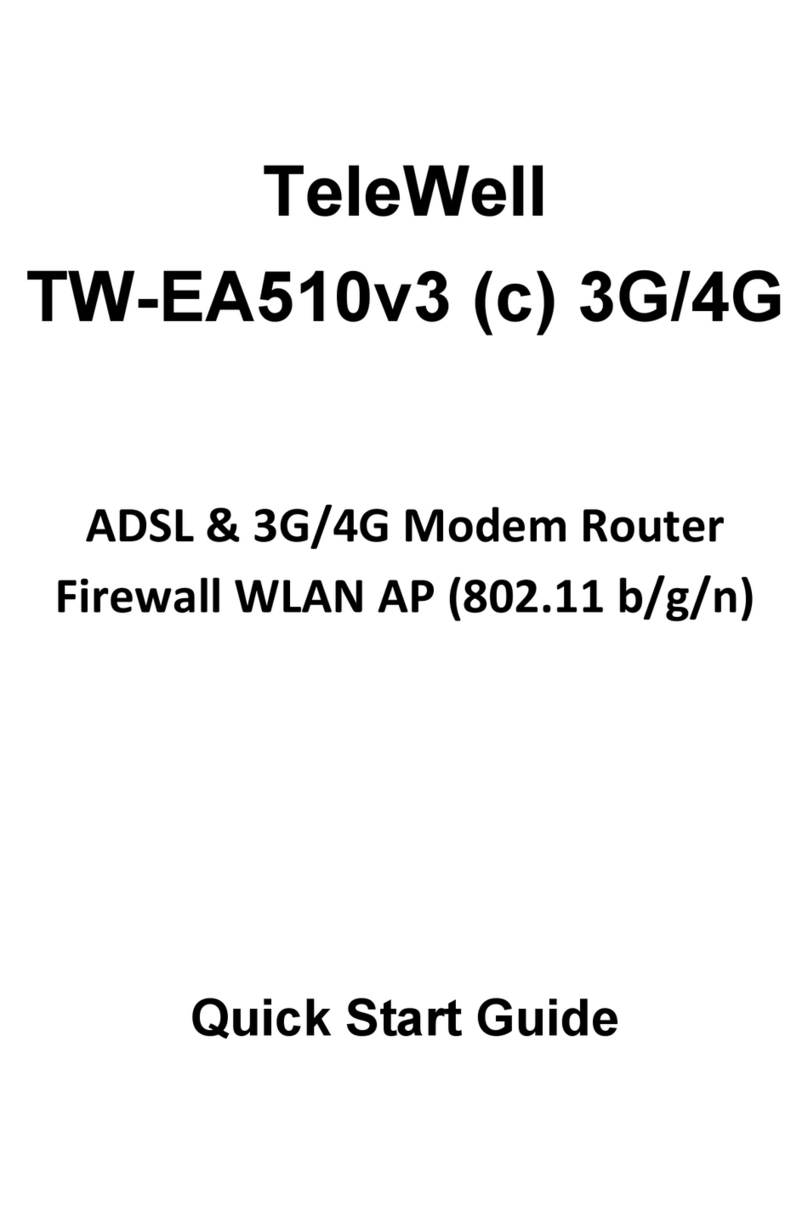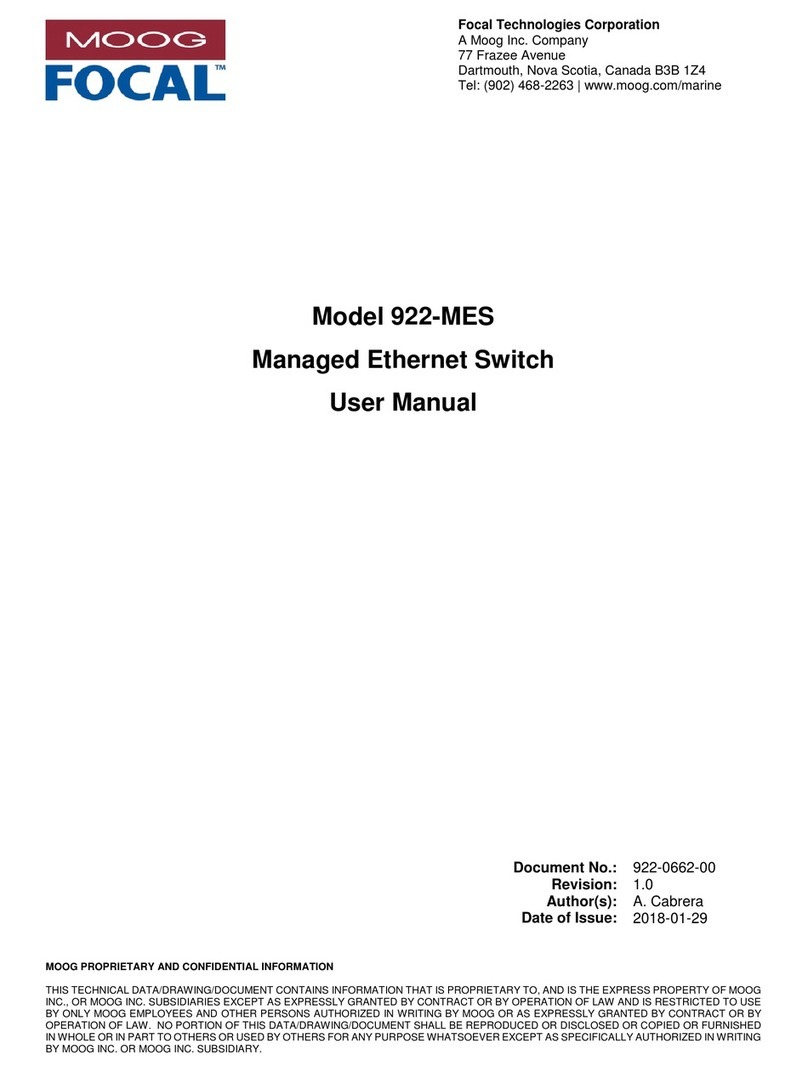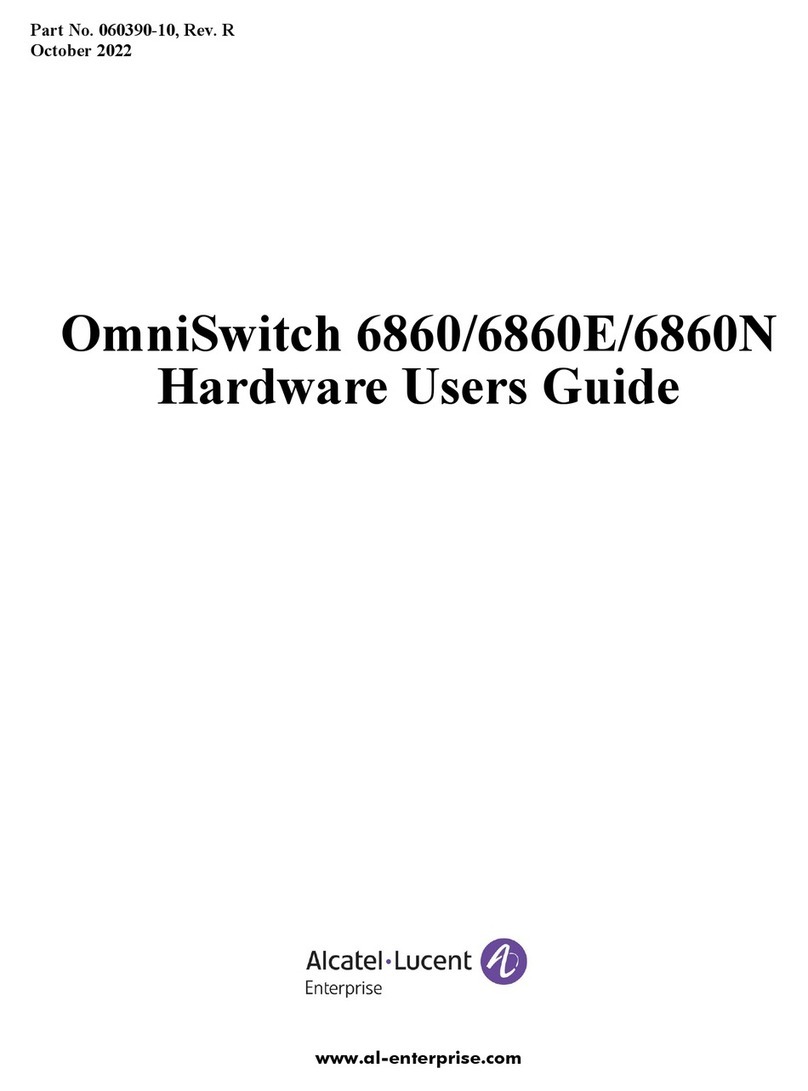INSYS Pocket ISDN User manual

Manual
Pocket ISDN
Nov-09


Copyright © November 09 INSYS MICROELECTRONICS GmbH
Any duplication of this manual is prohibited. All rights on this documentation and the
devices are with INSYS MICROELECTRONICS GmbH Regensburg.
Trademarks
The use of a trademark not shown below is not an indication that it is freely available for
use.
MNP is a registered trademark of Microcom Inc.
IBM PC, AT, XT are registered trademarks of International Business Machine Corporation.
INSYS ® is a registered trademark of INSYS MICROELECTRONICS GmbH.
Windows™ is a registered trademark of Microsoft Corporation.
Linux is a registered trademark of Linus Torvalds.
Publisher:
INSYS MICROELECTRONICS GmbH
Waffnergasse 8
D-93047 Regensburg, Germany
Phone: +49 (0)941/56 00 61
Fax: +49 (0)941/56 34 71
Internet: http://www.insys-tec.de
Date: Nov-09
Item: 31-22-06.002
Version: 4.0
Language: EN

Contents
4Nov-09
1Safety .................................................................................................................. 6
1.1 Usage According to the Regulations..................................................................................6
1.2 Permissible Technical Limits...............................................................................................7
1.3 Defects Liability Terms .......................................................................................................7
1.4 Labels and Symbols.............................................................................................................8
1.4.1 Symbols and Key Words ...................................................................................................8
1.5 Responsibilities of the Operator.........................................................................................9
1.6 Qualification of the Personnel ...........................................................................................9
1.7 Safety Instructions for Transport .......................................................................................9
1.8 Safety Instructions for Electrical Installation.....................................................................9
1.9 General Safety Instructions..............................................................................................10
2Scope of Delivery .............................................................................................. 11
3General Information ......................................................................................... 12
3.1 Product Description ..........................................................................................................12
3.2 Internet Access..................................................................................................................13
3.3 AOL/CompuServe Access ..................................................................................................13
3.4 T-Online.............................................................................................................................13
3.5 LAN Remote Access...........................................................................................................13
4Technical Data................................................................................................... 14
4.1 Physical Features ..............................................................................................................14
4.2 Technological Features.....................................................................................................14
4.3 Certifications.....................................................................................................................15
5Connections and LEDs ....................................................................................... 16
5.1 Front Panel........................................................................................................................16
5.2 Rear panel .........................................................................................................................17
5.3 Pin Assignment of the Serial Interface.............................................................................17
5.4 Pin Assignment of the S0 Interface..................................................................................18
6Function Overview............................................................................................ 19
7Meaning of the Symbols and the Formatting in this Manual.......................... 20
8Initial Operation................................................................................................ 21
9Operating Principle........................................................................................... 23
9.1 Operation with the Terminal Program.............................................................................23
10 Functions........................................................................................................... 24
10.1 Establishing or Accepting a Data Connection..................................................................24
10.2 Automatic call...................................................................................................................26
10.2.1 Configuring an Automatic Call.................................................................................... 26
10.2.2 Disabling an Automatic Call......................................................................................... 28

Contents
Nov-09 5
10.3 Data flow control..............................................................................................................29
10.3.1 Hardware Data Flow Control (RTS/CTS).................................................................... 29
10.3.2 Software Data Flow Control with XON/XOFF.......................................................... 29
10.4 Remote Configuration ......................................................................................................30
10.4.1 Remotely Configuring the Pocket ISDN..................................................................... 30
10.4.2 Configuring the Remote Configuration Number ................................................... 31
10.4.3 Configuring the Remote Configuration Password................................................. 31
10.4.4 Configuring the Permitted Callers for Remote Configuration............................ 32
10.5 Connection Configuration of the Pocket ISDN at the ISDN Basic Access........................33
10.5.1 Configuration at Multipoint Interface (PMP, Point-to-Multipoint) ................... 33
10.5.2 Configuration at Point-to-Point Interface (PTP, Point-to-Point)......................... 33
10.6 Security Callback (only Pocket ISDN Profi).......................................................................34
10.7 Selective Call Acceptance .................................................................................................35
10.8 TA+Configurator ...............................................................................................................36
10.9 Configuring the Transfer Protocol....................................................................................37
10.10 Outputting CLIP of Incoming Calls ...................................................................................38
10.11 User-to-User-Signalling (UUS1)........................................................................................39
10.12 Sub-Addressing .................................................................................................................40
10.13 Using Multilink PPP (only Pocket ISDN Internet).............................................................41
10.14 Details about Multilink PPP (only Pocket ISDN Internet) ................................................41
10.15 Call Bumping (only Pocket ISDN Internet) .......................................................................42
10.16 Bandwidth on Demand (BOD) (only Pocket ISDN Internet) ............................................43
10.17 Resetting the Device.........................................................................................................44
11 ISDN Error Messages ......................................................................................... 45
11.1 Extended Error Messages with ISDN................................................................................47
12 Maintenance ..................................................................................................... 51
13 Firmware History .............................................................................................. 53
13.1 Pocket ISDN Internet ........................................................................................................53
13.2 Pocket ISDN Profi ..............................................................................................................53
14 Waste Disposal.................................................................................................. 54
14.1 Repurchasing of Legacy Systems......................................................................................54
15 AT Command Reference ................................................................................... 55
16 Special ISDN Parameters................................................................................... 62
17 S Register........................................................................................................... 64
18 TA+Configurator Command Reference ............................................................ 65
19 Tables and Diagrams......................................................................................... 67
19.1 List of Tables .....................................................................................................................67
19.2 List of Diagrams ................................................................................................................67
20 Index.................................................................................................................. 68

Safety Pocket ISDN
6
1Safety
The Safety section provides an overview about the safety instructions, which must be
observed for the operation of the product.
The product is constructed according to the currently valid state-of-the-art technology
and reliable in operation. It has been checked and left the factory in flawless condition
concerning safety. In order to maintain this condition during the service life, the instruc-
tions of the valid publications and certificates must be observed and followed.
It is necessary to adhere to the general safety instructions must when operating the
product. The descriptions of processes and operation procedures are provided with pre-
cise safety instructions in the respective sections in addition to the general safety in-
structions.
An optimum protection of the personnel and the environment from hazards as well as a
safe and fault-free operation of the product is only possible if all safety instructions are
observed.
1.1 Usage According to the Regulations
The product may only be used for the purposes specified in the function overview. In ad-
dition, it may be used for the following purposes:
Data transmission functions in machines according to the machine direc-
tive 2006/42/EC.
Usage as data transmission device for a PLC or a usual PC.
The product may not be used for the following purposes and used or operated under the
following conditions:
Controlling or switching of machines and systems, which do not comply
with the directive 2006/42/EC.
Usage, controlling, switching and data transmission of machines and sys-
tems, which are operated in explosive atmospheres.
Controlling, switching and data transmission of machines, which may in-
volve risks to life and limb due to their functions or when a breakdown oc-
curs.

Pocket ISDN Safety
7
1.2 Permissible Technical Limits
The product is only intended for the use within the permissible technical limits specified
in the data sheets.
The following permissible limits must be observed:
The ambient temperature limits must not be fallen below or exceeded.
The supply voltage range must not be fallen below or exceeded.
The maximum humidity must not be exceeded and condensate formation
must be prevented.
The maximum switching voltage and the maximum switching current lo-
ad must not be exceeded.
The maximum input voltage and the maximum input current must not be
exceeded.
1.3 Defects Liability Terms
An usage according to the regulations, an ignorance of this documentation, the use of
insufficiently qualified personnel as well as unauthorised modifications exclude the li-
ability of the manufacturer for damages resulting from this. The liability of the manufac-
turer ceases to exist.

Safety Pocket ISDN
8
1.4 Labels and Symbols
1.4.1 Symbols and Key Words
Danger!
Risk of severe or fatal injury
One of this symbols in conjunction with the key word Danger
indicates an imminent danger. It will cause death or severe in-
juries if not avoid.
Warning!
Personal injury
This symbol in conjunction with the key word Warning indi-
cates a possibly hazardous situation. It might cause death or
severe injuries if not avoid.
Caution!
Slight injury and material damage
This symbol in conjunction with the key word Caution indicates
a possibly hazardous or harmful situation. It might cause slight
or minor injuries or a damage of the product or something in its
vicinity if not avoided.
Note
Improvement of the application
This symbol in conjunction with the key word Note indicates
hints for the user or very useful information. This information
helps with installation, set-up and operation of the product to
ensure a fault-free operation.

Pocket ISDN Safety
9
1.5 Responsibilities of the Operator
As a matter of principle, the operator must observe the legal regulations, which are valid
in his country, concerning operation, functional test, repair and maintenance of electrical
devices.
1.6 Qualification of the Personnel
The installation, commissioning and maintenance of the product must only be per-
formed by trained expert personnel, which has been authorised by the plant operator.
The expert personnel must have read and understood this documentation and observe
the instructions.
1.7 Safety Instructions for Transport
The following instructions must be observed:
Do not expose the product to moisture during transport. Pack product ac-
cordingly.
Pack product sufficiently to protect it against shocks during transport, e.g.
using air-cushioned packing material.
Check product for possible damages, which might have been caused by improper trans-
port, before installation. Transport damages must be noted down to the shipping docu-
ments. All claims or damages must be filed immediately and before installation against
the carrier.
1.8 Safety Instructions for Electrical Installation
The electrical connection must only be made by authorised expert personnel according
to the wiring diagrams.
The notes to the electrical connection in the manual must be observed. Otherwise, the
protection category might be affected.
The safe disconnection of circuits, which are hazardous when touched, is only ensured if
the connected devices meet the requirements of VDE T.101 (Basic requirements for safe
disconnection).
The supply lines are to be routed apart from circuits, which are hazardous when touched,
or isolated additionally for a safe disconnection.

Safety Pocket ISDN
10
1.9 General Safety Instructions
Caution!
Moisture and liquids from the environment may seep into the
interior of the product!
Fire hazard and damage of the product.
The product must not be used in wet or damp environments, or
in the direct vicinity of water. Install the product at a dry loca-
tion, protected from water spray. Disconnect the power supply
before you perform any work on a device which may have been
in contact with moisture.
Caution!
Short circuits and damage due to improper repairs and opening
of maintenance areas.
Fire hazard and damage of the product.
Only persons, which have the training or skills of an "Electronic
technician for industrial engineering", are authorised to open
and repair the product.
Caution!
Overcurrent of the device supply!
Fire hazard and damage of the product due to overcurrent.
The product must be secured with a suitable fuse against cur-
rents exceeding 1.6 A.
Caution!
Overvoltage and voltage peaks from the mains supply!
Fire hazard and damage of the product due to overvoltage.
Install suitable overvoltage protection.
Caution!
Damage due to chemicals!
Ketones and chlorinated hydrocarbons dissolve the plastic hou-
sing and damage the surface of the device.
Never let the device come into contact with ketones (e.g. ace-
tone) or chlorinated hydrocarbons, such as dichloromethane.

Pocket ISDN Scope of Delivery
11
2Scope of Delivery
The scope of delivery for the Pocket ISDN includes all accessories listed below. Please
check if all accessories are included in the box. If a part is missing or damaged, please
contact your distributor.
Please keep the packaging material for a possible future transport or storage.
Pocket ISDN
Power supply unit 230 V AC to 5 V DC
Cable:
1 ISDN cable (S0 cable)
1 PC connecting cable 9/9-pin (RS232 cable)
Manual
CD-ROM (optional)

General Information Pocket ISDN
12
3General Information
The Pocket ISDN is available in two versions. These are
Pocket ISDN Profi
Pocket ISDN Internet
Both versions of the Pocket ISDN differ in the following characteristics:
Pocket ISDN Internet Profi
CAPI interface Yes No
Multilink PPP Yes No
Security callback No Yes
X.25 No Yes
X.31 in D channel: No Yes
Table 1: Differences between Pocket ISDN Profi and Internet
Both versions are referred to as Pocket ISDN in the further course of this manual. If the
Pocket ISDN Profi differs from the Pocket ISDN Internet, this will be mentioned explicitly
in the respective sections.
Please note that you cannot use an ISDN device for digital data communi-
cation to establish a connection to an analogue modem.
3.1 Product Description
The Pocket ISDN connects a PC (or other device with a serial interface) to the ISDN net-
work. It provides access to online services like Internet, AOL/CompuServe and T-Online.
Moreover, point-to-point connections between two ISDN data terminal devices or a con-
nection to a GSM modem can be established. The Pocket ISDN can be considered as digi-
tal replacement for an analogue modem.
In order to operate the TA, you will need:
an ISDN basic rate interface (BRI) (replaces the analogue telephone connection). The
basic rate interface can be ordered with the telephone service provider.
a PC with serial RS232 interface (RS232)
The serial interface of the PC should be suitable for data rates of up to 115.2 kbps. It
might be possible that older PCs require an additional PC card for this.
It is possible to increase the data rates over the ISDN line to 230.4 kbps using Multilink
PPP with the Pocket ISDN Internet.

Pocket ISDN General Information
13
3.2 Internet Access
There are three methods for Internet access via ISDN:
with synchronous PPP or Multilink PPP (only with Pocket ISDN Internet)
with bit rate adaption V.120
with the B channel protocol X.75
It depends on the access devices of your Internet service provider (ISP) or point-of-
presence (POP), which protocol you can use.
Figure 1: Connection of the Pocket ISDN for access to an online service
3.3 AOL/CompuServe Access
The access to AOL/CompuServe via ISDN takes place using the V.120 or X.75 protocol (re-
fer to Figure 1). The protocol depends on the access devices of your AOL/CompuServe
dial-in node. The most frequently used common protocol is X.75.
3.4 T-Online
The T-Online (German online service) access via ISDN takes place using the T.70NL / X.75
or the synchronous PPP protocol (refer to Figure 1).
3.5 LAN Remote Access
You have to select the respective protocol of the ISDN router at the LAN for a remote ac-
cess to a LAN network.

Technical Data Pocket ISDN
14
4Technical Data
4.1 Physical Features
All specified data was measured with nominal input voltage, at full load, and an ambient
temperature of 25 °C. The limit value tolerances are subject to the usual variations.
Physical Feature Value
Operating voltage 5 V DC
Power consumption approx. 140 mA
Weight 150 g
Dimensions (Width x Depth x Height) 71 mm x 128 mm x 22 mm
Temperature range 0°C – 55
Maximum permissible humidity 95 % non-condensing
Table 2: Physical Features
4.2 Technological Features
Technological Feature Description
Protection class Housing IP40
Power supply interface ISDN network, S0 (U.430 Euro ISDN DSS1)
Transmission standards B channel
(Pocket ISDN Internet)
V.110, X.75, V.120, ML-PPP, HDLC (PPP)
Transmission standards D channel
(Pocket ISDN Internet)
DSS1
Transmission standards B channel
(Pocket ISDN Profi)
V.110, X.75, V.120, x.25/X.31, HDLC (PPP),
T70NL, T90NL
Transmission standards D channel
(Pocket ISDN Profi)
DSS1, 1TR6, VNx
Transmission speed 64 kbps, 128 kbps with channel bundling
(only Pocket ISDN Internet)
Table 3: Technological Features

Pocket ISDN Technical Data
15
4.3 Certifications
The Pocket ISDN has the following license number for the connection to the PSTN: CE-
0682 for Europe (EC), Switzerland and Norway. The Pocket ISDN is conform to the Euro-
pean safety requirements IEC 60 950.
The Pocket ISDN has been developed in compliance with the following guidelines and
standards:
R&TTE 1999/5/EG
DIN EN 55022 Class B
DIN EN 61000-6-2
DIN EN 60950-1
CTR3

Connections and LEDs Pocket ISDN
16
5Connections and LEDs
5.1 Front Panel
L1
L2
B1 R DCD
B2 T DTR
Pocket
ISDN
Figure 2: LEDs on the front panel
Description Col-
our
LED off LED on
L1 green Displays the state of the Pocket ISDN in encoded form
L2 yellow Displays the state of the Pocket ISDN in encoded form
B1 yellow B channel 1 offline B channel 1 online
B2 yellow B channel 2 offline B channel 2 online
R red No data is received Data is received
T red No data is sent Data is sent
DCD red No connection established Connection to remote terminal is es-
tablished
DTR red DTR line not activated DTR line activated
Table 4: Description of the LEDs on the front panel
The two LEDs L1 and L2 display the state of the Pocket ISDN according to following table
in encoded form.
L1 L2 Status Action
on blinking Start-up process Wait for start-up process
blinking off ISDN error Check ISDN interface/connector
on off active ISDN OK, no ISDN connection established
on flashing Call ISDN connection is being established
on briefly
off
Sync active Waiting for B channel synchronisation
on on Connection Data connection is established
off off TA error Hardware error, TA repair necessary
off blinking TA error Hardware error, TA repair necessary
flashing flashing Bootloader active No working firmware; update firmware
Table 5: Device status encoding by LED L1 and L2

Pocket ISDN Connections and LEDs
17
5.2 Rear panel
RS232
DC
ISDN
Figure 3: Connections on the rear panel of the device
Description Colour
DC Power supply (only the delivered power supply unit must be used)
ISDN ISDN interface (S0 interface)
RS232 Serial interface
Table 6: Description of the connections on the rear panel of the device
5.3 Pin Assignment of the Serial Interface
Figure 4: 9-pin Sub-D socket at the device
Pin Signal Description
1 DCD Data Carrier Detect
2 RXD Receive Data
3 TXD Transmit Data
4 DTR Data Terminal Ready
5 GND Ground
6 DSR Data Set Ready
7 RTS Request To Send
8 CTS Clear To Send
9 RI Ring Indication
Table 7: Description of the pin allocation of the Sub-D socket

Connections and LEDs Pocket ISDN
18
5.4 Pin Assignment of the S0 Interface
Figure 5: 8-pin Western connector (front view)
Pin Signal Description
1 - Not connected
2 - Not connected
3 a2 Tx + (Transmit +)
4 a1 Rx + (Receive +)
5 b1 Rx - (Receive -)
6 b2 Tx - (Transmit -)
7 - Not connected
8 - Not connected
Table 8: Description of the pin allocation of the RJ45 connector

Pocket ISDN Function Overview
19
6Function Overview
The Pocket ISDN provides you with the following functions:
Operation at ISDN point-to-point and multipoint interface
The Pocket ISDN can be operated at ISDN point-to-point interfaces as well
as at multipoint interfaces.
Different transfer protocols
The Pocket ISDN supports different transfer protocols, like e.g. X.75, V.110
and HDLC (for PPP connections).
Data buffering for serial transmission
The Pocket ISDN provides send and receive buffers to adjust the Pocket
ISDN to the data processing speed of the application.
Hardware and software data flow control
The Pocket ISDN can interrupt the data flow of the application via the con-
trol lines of the serial interface, if the buffers of the Pocket ISDN exceed a
certain level. An application can also prompt the Pocket ISDN via a control
line to interrupt the data flow. As an alternative, the Pocket ISDN can con-
trol the data flow via XOFF/XON characters in the data stream.
Selective Call Acceptance
The Pocket ISDN can be set to accept only calls from phone numbers that
were previously stored.
Security Callback (only Pocket ISDN Profi)
The called Pocket ISDN can initiate an automatic call to a predefined num-
ber, if a specified caller could be identified using CLIP.
Automatic call
The Pocket ISDN can initiate an automatic call either depending on the
DTR signal or independent of a status line.
Remote configuration
The Pocket ISDN can be configured remotely using another INSYS ISDN de-
vice and a terminal program.

Meaning of the Symbols and the Formatting in this
Ml
Pocket ISDN
20
7Meaning of the Symbols and the Formatting in this
Manual
This section describes the definition, formatting and symbols used in this manual. The
various symbols are meant to help you read and find the information relevant to you.
The following text is structured like a typical operating instruction of this manual.
Bold print: This will tell you what the following steps will result in
After that, there will be a detailed explanation why you could perform the
following steps to be able to reach the objective indicated first. You can de-
cide whether the section is relevant for you or not.
An arrow will indicate prerequisites which must be fulfilled to be able to
process the subsequent steps in a meaningful way. You will also learn
which software or which equipment you will need.
1. One individual action step: This tells you what you need to do at this point.
The steps are numbered for better orientation.
A result which you will receive after performing a step will be marked with
a check mark. At this point, you can check if the previous steps were suc-
cessful.
Additional information which you should consider are marked with a cir-
cled "i". At this point, we will indicate possible error sources and tell you
how to avoid them.
Alternative results and steps are marked with an arrow. This will tell you how
to reach the same results performing different steps, or what you could do if
you didn't reach the expected results at this point.
Other manuals for Pocket ISDN
1
Table of contents
Other INSYS Network Router manuals
Popular Network Router manuals by other brands
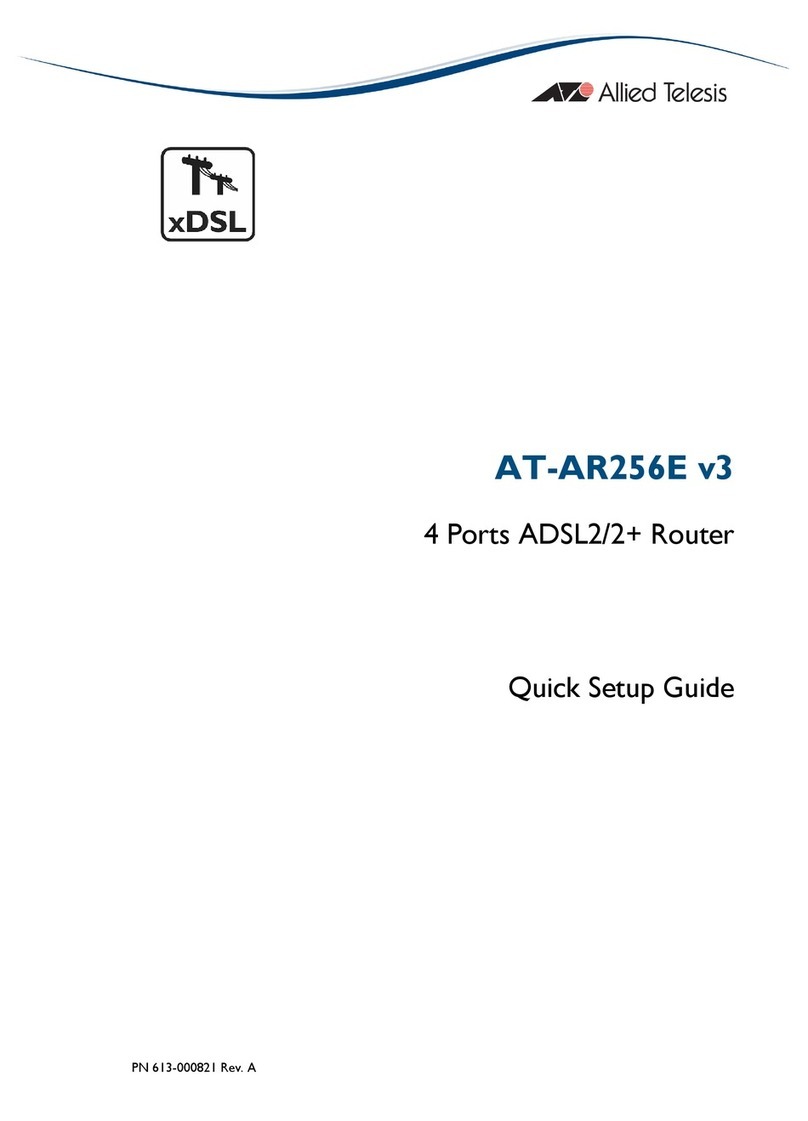
Allied Telesis
Allied Telesis AT-AR256E v3 Quick setup guide
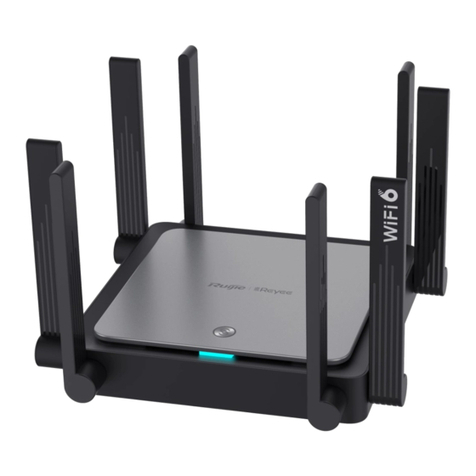
Ruijie
Ruijie Reyee RG-EW3200GX PRO product manual
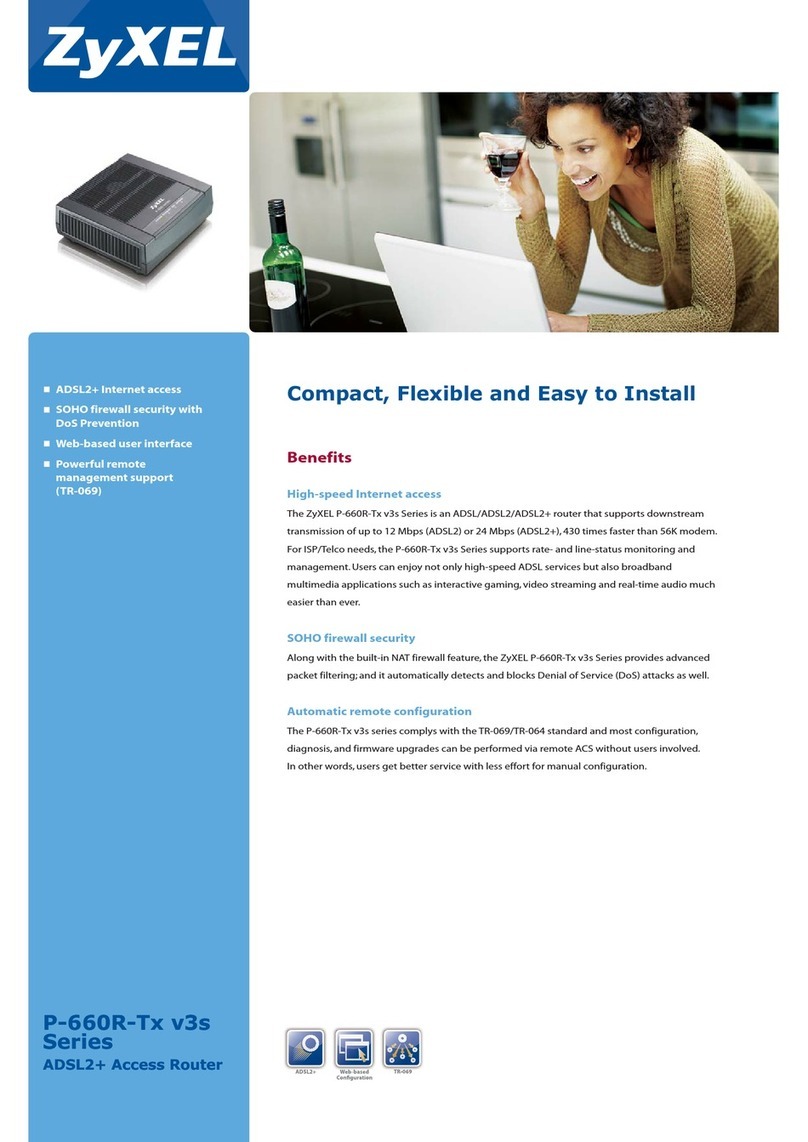
ZyXEL Communications
ZyXEL Communications P-660R-Tx v3s Series Specifications
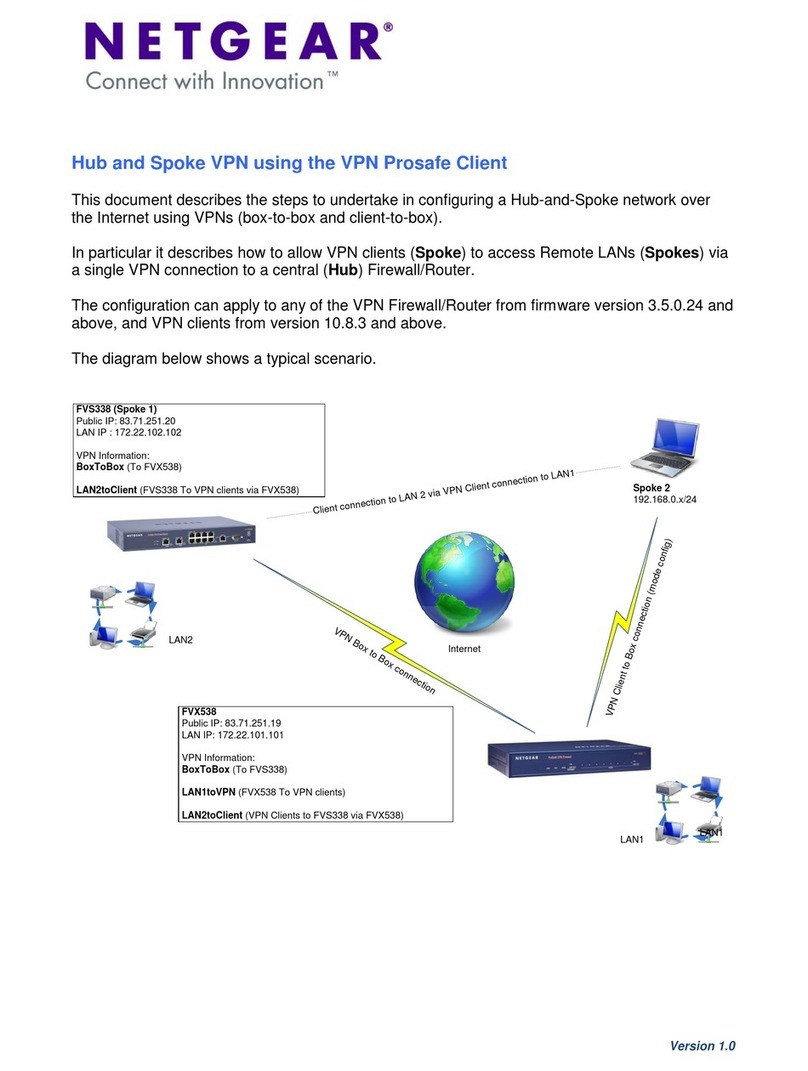
NETGEAR
NETGEAR DGFV338 - ProSafe Wireless ADSL Modem VPN Firewall... Network Setup
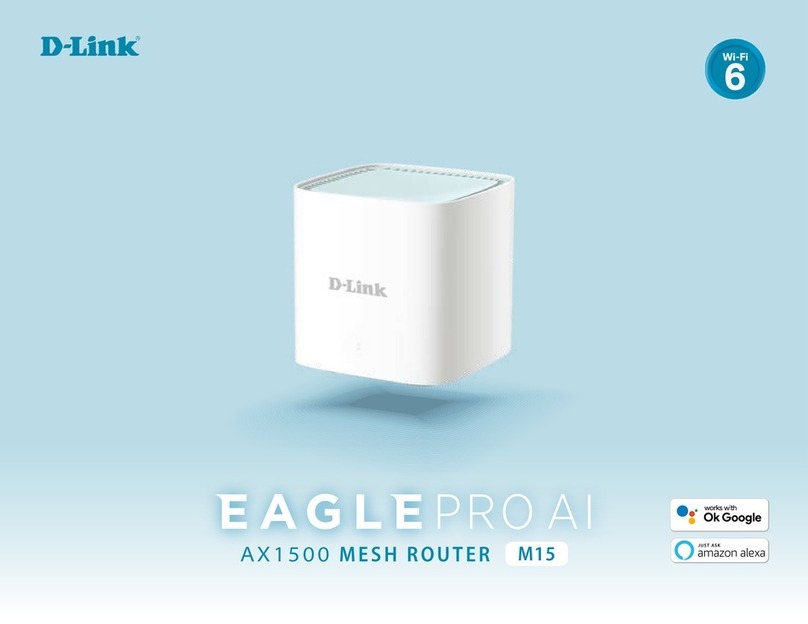
D-Link
D-Link M15-2PK manual
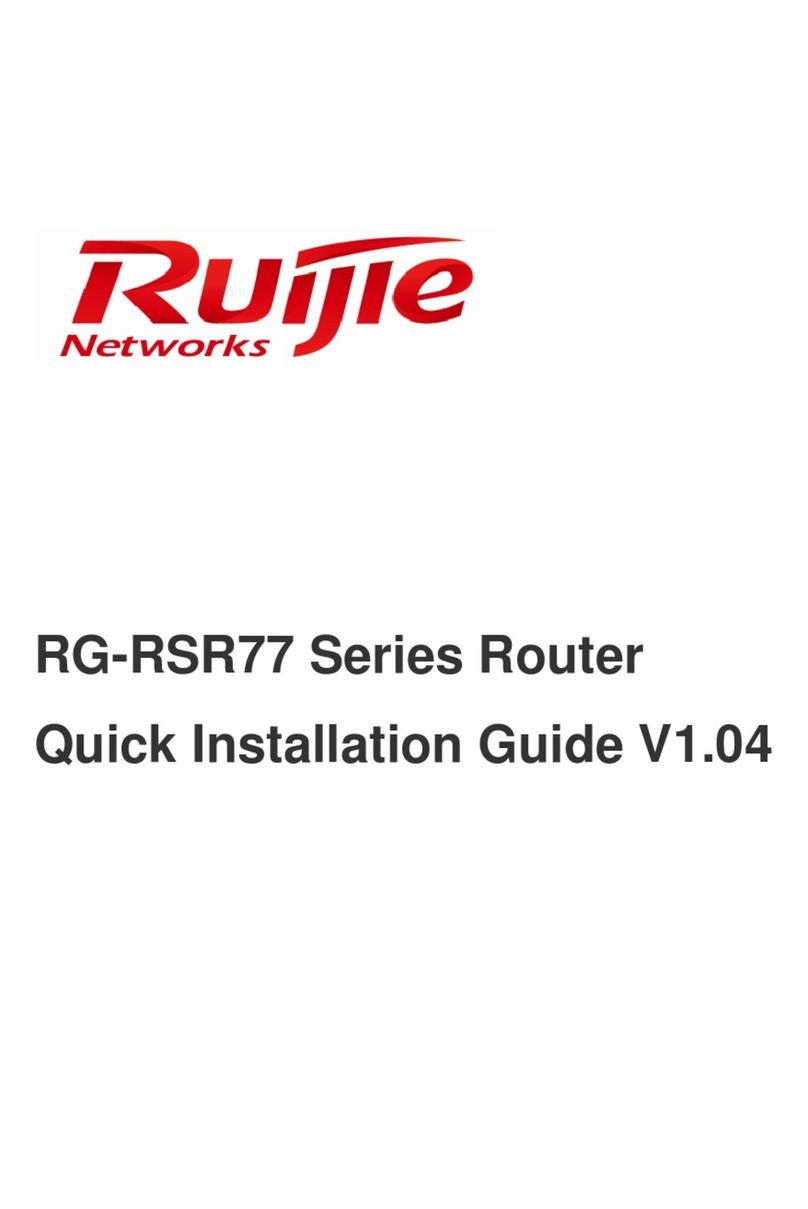
Ruijie
Ruijie RG-RSR77 Series Quick installation guide
